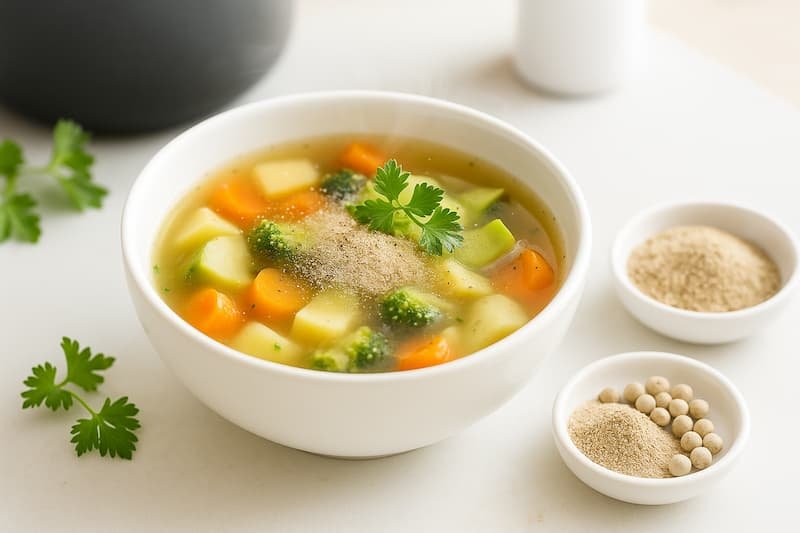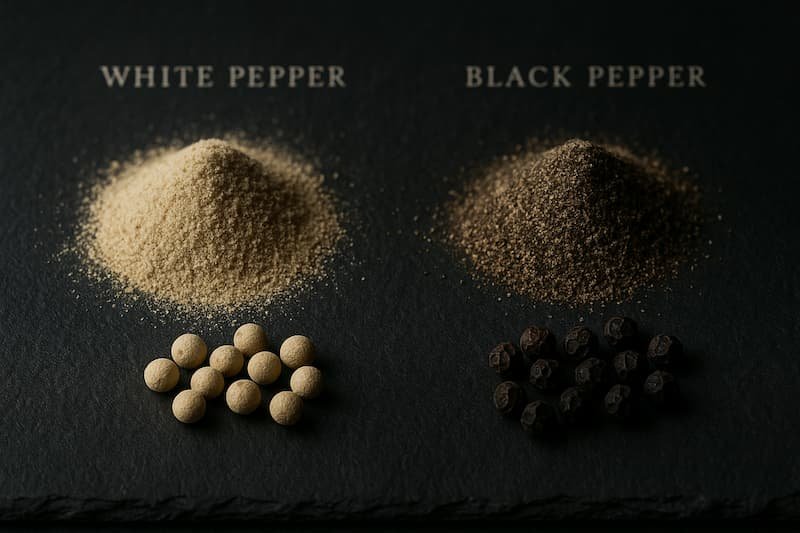White Pepper Powder: Amazing Uses for Better Wellness
They remember the first time a bowl of hot rasam cleared a foggy head on a monsoon evening. In that steam rose a mellow heat—not sharp, but deep and soothing. That warmth came from White Pepper Powder, a quiet staple in many Indian kitchens, and a gentle ally for everyday wellness.
Across India, cooks reach for this spice when a dish needs lift without dark flecks. Beyond taste, people turn to it for comfort—settled stomachs, lighter meals, and a calm, warm finish. Researchers link piperine, its key alkaloid, with anti-inflammatory and antioxidant actions, and even improved absorption of certain nutrients. For those seeking white pepper benefits that fit real life, the path begins at the table.
White pepper nutrition adds fiber and trace minerals with modest calories, making it a smart choice for simple, home-cooked food. Early studies point to support for digestion and gut comfort, while traditional systems in India have long used it to warm the body and clear heaviness. In kitchens and clinics alike, the health benefits of white pepper powder invite a closer look at how small habits can shape long-term well-being.
From light soups to delicate gravies, white pepper uses are practical and precise. When people talk about white pepper for health, they are often talking about small, daily choices that feel good and taste right. This article explores what the science suggests, how to use it, and where it fits into a balanced life.
Key Takeaways
- White Pepper Powder offers gentle heat and clean flavor that suits Indian soups, gravies, and light sauces.
- Piperine underpins many white pepper benefits, including antioxidant and anti-inflammatory actions.
- Evidence suggests support for digestion and gut comfort, aligning with traditional use across India.
- White pepper nutrition provides fiber and key minerals with modest calories.
- Early research indicates enhanced absorption of certain compounds, adding practical value for white pepper for health.
- Everyday white pepper uses can deliver the health benefits of white pepper powder without overpowering dishes.
What Is White Pepper and How It Differs from Black Pepper
Both spices come from Piper nigrum. But, they differ in the kitchen. The main difference is in how the berries are treated after picking. This affects their taste, color, and appearance and culinary use.
Processing: Retting and Skin Removal vs. Whole Dried Drupes
Black pepper comes from unripe drupes. They are briefly heated and sun-dried. The whole pericarp stays on before grinding. This keeps many volatile aromas.
White pepper starts with nearly ripe berries. They are soaked to remove the dark skin. Then, they are dried and milled. This process makes white pepper taste and look different.
Flavor, Aroma, and Shelf-Life Differences
White pepper tastes cleaner and sharper. Black pepper has a deeper bouquet from its outer layer. White pepper has a bite but fewer floral notes.
White pepper’s aroma fades faster. Black pepper keeps its character longer. This is important for storage.
White pepper vs black pepper: appearance and culinary use cases
White pepper is great for smooth gravies and white sauces. It doesn’t add dark flecks. Chefs in India and other places use it for a subtle pepper flavor.
Black pepper is good for bold marinades and rubs. It adds specks and a layered aroma. The choice depends on the dish’s look and taste you want.
White Pepper Powder

White Pepper Powder is made from the core of peppercorns. It’s known as Safed Mirch in India. The outer layer is removed, so it’s smooth and adds a gentle heat.
It’s great in creamy dishes like gravies and mashed potatoes. It also works well in light soups and broths. To use it, add a little at the end of cooking and adjust as needed.
Scientists have studied its ingredients, like piperine, using special tests. These tests help ensure the quality of packaged spices in India.
People use white pepper powder in many ways. It’s good in chicken stew, white gravies, and béchamel sauce. It’s also great in egg dishes and seafood for a clean look.
For best results, use fresh White Pepper Powder and keep it in an airtight container. Whether it’s called Safed Mirch or white pepper, use it sparingly. This way, you can enhance flavors without darkening your dishes.
White Pepper Nutrition and Key Phytochemicals
White pepper powder adds a subtle heat to our meals in India. It brings a mix of energy, minerals, and plant compounds. These support balanced diets. Researchers study its bioactive profile to understand its effects in the body.
Macronutrients and Micronutrients: Fiber, Manganese, Iron
One tablespoon (about 7 g) has about 20.7 kcal. It has 4.8 g carbohydrates, 0.7 g protein, and 0.1 g fat. It also has 1.8 g of dietary fiber, helping to keep recipes light.
In terms of fiber manganese iron, it gives about 0.3 mg manganese (~15% DV) and 1 mg iron (~6% DV). It also has 0.1 mg copper (~3% DV), 1.5 mg vitamin C (~2% DV), 18.6 mg calcium (~2% DV), and 6.3 mg magnesium (~2% DV). It has smaller amounts of riboflavin, phosphorus, and zinc.
| Nutrient | Per Tbsp (~7 g) | Dietary Context |
| Energy | ~20.7 kcal | Low-calorie flavor boost |
| Carbohydrates | 4.8 g | Primarily from plant matrix |
| Protein | 0.7 g | Minor contribution |
| Fat | 0.1 g | Negligible |
| Dietary Fiber | 1.8 g | Supports regularity |
| Manganese | ~0.3 mg (~15% DV) | Enzyme cofactor |
| Iron | ~1 mg (~6% DV) | Oxygen transport |
| Copper | ~0.1 mg (~3% DV) | Redox balance |
| Vitamin C | ~1.5 mg (~2% DV) | Antioxidant support |
| Calcium | ~18.6 mg (~2% DV) | Bone health |
| Magnesium | ~6.3 mg (~2% DV) | Metabolic function |
Piperine and other piperamides identified by HPLC/LC-MS
Scientists study white pepper nutrition to understand its alkaloid profile. They use HPLC and LC-MS to find piperine and related piperamides. These compounds shape its pungency and bioactivity.
Levels can change based on origin, processing, and storage. This profiling helps ensure quality. It gives chefs and dietitians insight into how grind, heat, and time affect flavor and function.
Antioxidants: Polyphenols and flavonoids linked to oxidative stress reduction
White pepper powder also has antioxidant families like polyphenols flavonoids. These compounds fight free radicals and reduce lipid oxidation in foods.
Piperine works with these compounds. Together, they create the antioxidant profile of white pepper. This supports its use in soups, gravies, and light sauces in India.
Health Benefits of White Pepper Powder for Digestion

White pepper is used in India for its gentle heat. It’s good for the stomach but lively for taste. It has piperine, which helps with digestion.
Note the balance: it has a subtle aroma and releases taste quickly. It’s great in clear soups and cream gravies. People in India like it because it adds warmth without black specks.
Stimulation of pancreatic enzymes: lipase, amylase, trypsin, chymotrypsin (animal studies)
K. Srinivasan at the Central Food Technological Research Institute found piperine boosts digestive enzymes. Studies showed it increases lipase, amylase, trypsin, and chymotrypsin. This supports the idea of using white pepper for light meals.
Using white pepper helps season food lightly but deeply. This makes meals less heavy and leaves a clean taste.
Gastrointestinal motility and transit time evidence
Studies on animals show piperine changes intestinal secretion and shortens transit time. It affects gut motility and gastric secretions. This supports the use of white pepper in cooking.
These findings explain why people use white pepper for digestion in soups and porridges. It helps these dishes digest smoothly.
White pepper powder for digestion: practical culinary uses in India
Home cooks add white pepper to light rasam and clear soups. It’s used in North Indian kitchens for cream gravies and white stews. It adds warmth without overpowering flavors.
Use white pepper to finish dishes like egg drop soup and lemon-coriander broth. It keeps the aroma bright and supports digestion with piperine. This way, you get the benefits without too much heat.
Anti-Inflammatory and Antioxidant Potentials
White pepper has benefits from piperine and other compounds. They work as anti-inflammatory and antioxidants. In Indian kitchens, it adds flavor and health benefits to everyday dishes.
Note: The insights below reflect laboratory and animal research alongside spice chemistry, giving context for home use.
Piperine’s anti-inflammatory actions in preclinical models
In studies, piperine reduced inflammation and joint swelling. A study in Arthritis Research & Therapy by Seung Ho Bang found less pain in arthritis models. Mi Ran Woo’s team in Life Sciences showed lower inflammation in fat tissue.
Using white pepper in soups or gravies is practical. It adds benefits without changing the dish’s taste. This makes it easy to include in daily meals in India.
Reduction of lipid peroxidation and oxidative stress markers
Piperine lowered lipid peroxidation in rats, as K. A. Dhuley found. This antioxidant effect is also seen in Piper species’ polyphenols and flavonoids. They help manage oxidative stress.
For recipes, use gentle heat and add white pepper late. This preserves aroma and keeps antioxidants active. It’s best for clear soups, rasam, and steamed fish.
Implications for chronic inflammation–related conditions
Piperine’s dual action suggests it supports diets focused on long-term health. Human trials on white pepper are limited. But, regular use in cooking aligns with balanced diets.
In homes, add small amounts to khichdi, poached eggs, or sauces. This way, white pepper’s benefits can be part of regular meals without overpowering taste or smell.
| Aspect | Key Insight | Representative Source | Practical Kitchen Tip (India) |
| Inflammation Modulation | Piperine reduces joint swelling and inflammatory markers in models | Bang et al., Arthritis Research & Therapy (2009) | Add a pinch to dal or soup after cooking to retain anti-inflammatory aroma |
| Adipose Tissue Signaling | Lower macrophage activity and MCP-1 in preclinical work | Woo et al., Life Sciences (2007) | Use in light gravies where pepper notes remain clean and gentle |
| Lipid Peroxidation | Inhibition during experimental inflammation aligns with antioxidant action | Dhuley, Indian Journal of Experimental Biology (1993) | Season near serving time to support antioxidant intent |
| Dietary Context | White pepper for health fits balanced, minimally processed diets | Evidence synthesis across Piper species research | Use small, frequent amounts in rasam, steamed fish, or vegetable clear broths |
White Pepper for Diarrhea and Gut Comfort
In India, families often use India home remedies for stomach issues. They add white pepper powder to foods like congee or thin dal to help with diarrhea. This is seen as a gentle way to support gut health.
Clinical evidence: stir-fried white pepper in infants and children
A study in the American Journal of Chinese Medicine (2013) found white pepper helps with loose stools in kids. It worked for both short and long-term cases. This matches how cooks use a little white pepper in mild dishes.
Antidiarrheal effects of piperine in animal models
Studies in Planta Medica (2001) and Life Sciences (2002) show piperine’s benefits. It helped mice with diarrhea and might make stool more regular. This could help with digestion.
How to use white pepper safely during recovery
When you’re getting better, use white pepper carefully. Add a little to foods like rice congee or clear soup. This adds flavor without upsetting your stomach.
- Start with a small pinch once or twice a day and observe tolerance.
- Pair with warm fluids and oral rehydration as advised by a clinician.
- Avoid high doses, fried foods, and eye contact due to irritation risk.
Always talk to a doctor if you’re a parent or if symptoms are bad. Home remedies can help, but always get professional advice first.
| Use Case | Preparation | Typical Amount | Notes for Gut Comfort |
| Rice congee | Cook rice until porridge-like; add white pepper powder and salt | 1 small pinch per bowl | Soft texture and warmth aid intake during recovery |
| Clear chicken or vegetable soup | Simmer stock; finish with white pepper powder and ginger | 1 small pinch per serving | Mild spice supports appetite while staying light |
| Moong dal khichdi | Pressure-cook split moong with rice; season gently | 1 pinch in the pot | Easy to digest; pairs well with oral fluids |
| Curd rice (when tolerated) | Mix plain yogurt with soft rice; add a hint of white pepper | A few sprinkles | Use only if dairy is tolerated; keep spice minimal |
These dishes keep flavors interesting while being gentle on your stomach. Used wisely, they follow India’s home remedy traditions and new research.
Cardiovascular Support and Blood Pressure Insights
White pepper adds bold flavor without much sodium. This helps cooks in India use less salt. It’s good for blood pressure because it makes meals heart-friendly.
It’s great in dal, rasam, and light gravies. White pepper is a healthy choice for many dishes.
Research shows white pepper might help the heart. It could lower blood pressure in rats. It also relaxes blood vessels and fights oxidative stress.
Practical use means using it in small amounts. Add it to soups, steamed veggies, or fish. This keeps meals tasty without too much salt.
In India, it’s used with tomatoes, spinach, and legumes. This makes meals light but filling. It’s a good choice for a heart-healthy diet.
| Aspect | How White Pepper Helps | Culinary Tips for India | Relevance to Blood Pressure |
| Sodium Load | Adds flavor without sodium | Use in rasam, khichdi, and light paneer gravies | Supports reduced salt intake |
| Vascular Tone | Piperine linked to vasodilation in vitro | Finish soups with a pinch before serving | May aid cardiovascular support |
| Oxidative Stress | Antioxidant actions target free radicals | Combine with leafy greens and tomatoes | Helps maintain vascular integrity |
| Diet Pattern Fit | Integrates with produce- and legume-rich meals | Season sprouted moong salads and steamed fish | Complements blood pressure goals |
- Start with 1/4 to 1/2 teaspoon per dish to balance heat and aroma.
- Pair with garlic, ginger, and lemon for bright flavor without extra salt.
- Choose fresh-ground peppercorns and store airtight to preserve potency.
Curcumin Absorption and Synergy with Turmeric
Indian homes mix turmeric with white pepper for more than taste. They add a bit of white pepper to yellow dishes. This helps the curcumin absorb better and keeps the dish looking clean.
Piperine’s role in bioavailability enhancement
Piperine from pepper slows down gut enzymes. Studies show it helps turmeric get absorbed better. Adding fat makes this effect even stronger.
Evidence for increased curcumin absorption
Studies on piperine show it increases levels of compounds in the blood. This is seen in Planta Medica and other journals. It makes curcumin absorption much better in both animals and humans.
How to combine turmeric and white pepper in cooking
In India cooking, mix haldi with warm oil and a pinch of white pepper. This choice keeps sauces bright and helps absorption. Try it in dals, kitchari, and light curries for a nice flavor and color.
| Aspect | Turmeric with White Pepper | White Pepper vs Black Pepper | Practical Tip |
| Absorption Aid | Contains piperine that boosts curcumin absorption and supports bioavailability | White pepper gives cleaner look; black pepper adds visible specks | Use a pinch with a fat source for better uptake |
| Flavor Impact | Mild heat that lets turmeric shine | White is gentle; black is sharper and more resinous | Choose white for soups and pale gravies |
| Culinary Fit | Ideal for India cooking classics like dal tadka, kitchari, and light curries | White suits creamy sauces; black suits robust masalas | Add near the end to preserve aroma |
| Visual Result | Speck-free yellow finish | White pepper vs black pepper determines final appearance | Pick white when presentation matters |
White Pepper Uses: Cooking, Traditional Medicine, and Skin Care
White pepper is a mix of tradition and modern cooking. It adds heat without the black specks. In traditional medicine, it’s valued for its warmth.
Beauty lovers use it in gentle skin care routines. But, they must be careful and use it wisely.
How to use white pepper powder in cooking: soups, gravies, light sauces
White pepper adds a subtle heat to pale dishes. It’s great in cream of mushroom soup and white gravies. It also works well in mashed potatoes and fried rice.
For a light touch, add it to béchamel or pasta sauces. It won’t change the color. Try it in Chinese Hot and Sour soup or Vietnamese soups for depth.
In India, it’s used in light sauces for fish, paneer, or vegetables. To use it, bloom it in ghee or oil for 20–30 seconds. Then, add salt and acid for balance.
Traditional Chinese Medicine and Ayurveda context in India
In TCM, white pepper warms the middle and clears phlegm. It’s used in cool, humid weather. It helps with joint and chest comfort.
In Ayurveda, it’s heating and good for kapha. Use it in teas, rasam, or buttermilk for digestion. Some mix it with long pepper and ginger for heart health.
White pepper powder for skin care and hair: what evidence says
DIY skin care uses white pepper powder in scrubs with oatmeal or honey. For hair, it’s in yogurt masks for dandruff. But, there’s limited scientific proof.
Always test it first and avoid sensitive areas. If irritation happens, rinse with cool water and stop. For serious issues, see a dermatologist.
- Kitchen tip: Mix into warm cream or stock to avoid clumps and preserve aroma.
- Tradition note: TCM and Ayurveda emphasize small, frequent doses aligned with body type and season.
- Care tip: Keep DIY amounts minimal and wash hands well after handling.
White pepper is great for cooking and traditional medicine. It’s also used in skin care. But, use it carefully and follow safety tips.
White Pepper vs Black Pepper: Which to Choose?

Indian kitchens often debate between white and black pepper. They look at flavor, color, and health benefits. Both come from Piper nigrum, but processing changes their aroma and shelf life.
Cooks also compare white and black pepper powder for soups, gravies, and sauces.
Tip: Grind whole peppercorns just before cooking. This keeps volatile notes in both white and black pepper powder.
Overlap in health benefits due to shared piperine
Studies show both peppers support digestive enzymes and have antioxidant effects. This is why white pepper benefits are similar to black pepper’s.
Research also suggests piperine boosts bioavailability. Both peppers have piperamides, but processing changes their aroma.
When to choose white pepper for flavor and aesthetics
Use white pepper powder in light dishes like gravies, cream soups, and mashed potatoes. It adds a clean heat without dark specks.
Black pepper is better for strong flavors like pepper chicken and spice rubs. Its aroma lasts longer, making it great for batch cooking.
Difference between white and black pepper powder in recipes
You can substitute them one-for-one by volume. Adjust to taste. White pepper has a smoother heat; black pepper is brighter and more resinous.
White pepper loses aroma quickly. Grind it fresh at the stove and serve the dish right away. This keeps its flavor and color perfect.
- Soups and sauces: white for clarity; black for punch.
- Dry rubs: black for aroma length; mix in white for gentler bite.
- Everyday seasoning: blend both to balance heat and fragrance.
| Aspect | White Pepper | Black Pepper |
| Processing | Ripe berries retted, skin removed | Whole dried drupes with outer skin |
| Flavor Profile | Clean, even heat; subtle, earthy notes | Robust, complex; woody and citrus-like |
| Appearance in Food | No dark specks; ideal for pale dishes | Visible specks; rustic look |
| Aroma Longevity | Shorter; best when freshly ground | Longer; holds up in storage |
| Core Bioactives | Piperine and related piperamides | Piperine and related piperamides |
| Best Uses in India | Light gravies, cream soups, egg curries | Pepper chicken, grills, bold masalas |
Safety, Side Effects, and Interactions
White pepper is safe for most people in cooking. But, it’s important to use it wisely. Small amounts in India help avoid problems.
GRAS status and general culinary safety
Pepper is safe for food in the US. A little white pepper in soups or sauces is okay for adults. But, kids, pregnant women, and those with health issues should use it carefully.
Mucosal irritation, sneezing, and eye exposure precautions
White pepper can irritate your nose and throat. It might make you sneeze or cough. If it gets in your eyes, rinse them with water until the pain goes away.
Be careful when grinding pepper near steam. Keep the lid on, add spice when it’s cool, and don’t lean over the pan.
Allergy to pepper is rare but possible. Workers who handle a lot of spice might get rhinoconjunctivitis. This includes a runny nose, itchy eyes, and wheezing. If you notice these symptoms, stop using white pepper and see a doctor.
Drug interactions: P-glycoprotein and CYP3A4 inhibition considerations
Piperine in white pepper can affect how your body handles drugs. It might change levels of certain medicines. Studies have shown this with phenytoin, propranolol, and theophylline.
If you’re taking medicines that need careful dosing, talk to your doctor about white pepper. The elderly and those with liver problems should also be cautious. Watch for side effects if you start a new medicine or change your dose.
Buying, Storage, and Best Recipes with White Pepper Powder
Buying white pepper in India is easy. You can find it in supermarkets, spice bazaars, and online on BigBasket and Amazon India. For the best smell, buy whole peppercorns from brands like Everest, Catch, and 24 Mantra Organic. Then, grind them fresh.
Quality depends on the harvest and how it’s processed, as Cao et al. (2009) found. Look for recent pack dates, even color, and a fresh smell. Avoid old, dusty pepper with a bad smell.
For keeping flavor, use good storage tips. Store white pepper in an airtight jar, in a cool, dark place. It loses its smell faster than black pepper, so buy small amounts and use them up quickly. Grind whole peppercorns just before using.
Wondering how to use white pepper powder in cooking? It’s great in light sauces and gentle dishes. Add it towards the end of cooking to keep its smell. Use it in small amounts.
- Soups and broths: Hot and Sour soup, Vietnamese-style pho, chicken sweet corn soup.
- Creamy bases: white gravies, mashed potatoes, chowders, and cream sauces.
- Rice and stir-fries: fried rice, egg fried rice, light vegetable sautés.
- Indian dishes: mild kurma, paneer in white gravy, appam stew, convalescent khichdi.
For tasty pairings, mix white pepper with turmeric and a fat like ghee or coconut milk. This helps your body absorb nutrients and keeps flavors balanced.
| Aspect | Whole White Peppercorns | Ground White Pepper Powder | Practical Tip for India |
| Aroma & Shelf Life | Stronger, lasts longer when sealed | Fades faster after opening | Buy small whole packs; grind weekly |
| Control of Grind | Custom fine-to-medium textures | Fixed, ultra-fine texture | Use a burr grinder or mortar and pestle |
| Culinary Use | Finish soups, broths, cream sauces | Quick seasoning for fried rice and gravies | Add at the end to keep aroma intact |
| Availability | Found in spice bazaars and premium aisles | Widely stocked in supermarkets and online | Check brands like Everest, Catch, 24 Mantra Organic |
| Best Practice | Purchase fresh, recent pack dates | Store airtight, away from light | Rotate monthly to avoid staleness |
The best recipes with white pepper powder need a light touch. Start with 1/4 teaspoon per liter of soup or sauce. Taste and adjust as needed. In recovery diets, use gentle seasoning to keep flavors lively.
Conclusion
White Pepper Powder comes from Piper nigrum seeds. It adds a clean heat and a subtle aroma to Indian cooking. It’s rich in fiber, manganese, and iron, but low in fat.
Its piperine helps with digestion, as Indian research shows. It’s great in light soups, gravies, and cream sauces. This keeps the colors bright and flavors balanced, which is important in Indian cooking.
White pepper has more than just taste benefits. Studies show it helps with digestion and has antioxidant and anti-inflammatory effects. It also helps the body absorb curcumin better, making it a good match for turmeric.
This makes white pepper a smart choice for health. It’s a natural way to improve your diet without overpowering your food.
In the debate of white pepper vs black pepper, both have piperine. But white pepper is better for pale sauces, egg dishes, and mild broths. Black pepper is better for bold marinades and coarse rubs.
It’s important to use white pepper in the right amounts. Too much can irritate your mucosa or interact with certain drugs. Used correctly, White Pepper Powder can enhance flavors and support a balanced diet in India.
FAQ
What is white pepper powder and where does it come from?
White pepper powder is made from the seeds of mature peppercorns. The outer skin is removed, then the pale core is dried and ground. It’s popular in Indian, Chinese, and Vietnamese cooking.
How does white pepper differ from black pepper?
Both come from the Piper nigrum vine. Black pepper is the whole unripe drupe, while white pepper is the seed without skin. White pepper tastes cleaner and has less aroma.
White pepper vs black pepper: which should be used in light sauces and soups?
Use white pepper in cream sauces and pale soups. It avoids black specks. Black pepper is better for robust dishes because of its strong aroma.
What are the main white pepper benefits for everyday cooking?
It adds gentle heat and blends well. It’s good with dairy and broths. It also pairs well with turmeric in dals and gravies.
What nutrients are in white pepper powder?
One tablespoon has about 20.7 kcal, 1.8 g fiber, and some protein and minerals. It has manganese and iron.
What bioactive compounds make white pepper useful for health?
Piperine is the main compound. It has antioxidant and anti-inflammatory effects. It also helps with nutrient absorption.
How does white pepper act as an antioxidant?
Its polyphenols and flavonoids reduce oxidative stress. This is seen in animal studies.
How does white pepper support digestion?
Piperine boosts digestive enzymes. This helps break down fats and carbs. It supports digestion.
Is there evidence that white pepper affects gut motility?
Yes, it can speed up digestion in animals. But human studies are limited.
How to use white pepper powder for digestion in Indian cooking?
Add a pinch to soups, rasam, and clear broths. It adds warmth without heat.
Does white pepper have anti-inflammatory benefits?
Yes, it reduces inflammation in animal studies. It may help with joint pain and metabolic health.
Can white pepper help reduce oxidative stress?
Yes, it reduces oxidative damage in animals. It’s good with fruits and veggies.
What are the implications for chronic inflammation?
It may help with joint pain and metabolic health. But it’s not a cure-all.
Is white pepper good for diarrhea and gut comfort?
A study showed it helps with diarrhea in kids. It also has antidiarrheal effects in animals.
How should white pepper be used during recovery from GI upset?
Use small amounts in rice congee and soups. Avoid too much. Stay hydrated and seek medical advice.
Are there cardiovascular benefits to white pepper?
It may help with blood pressure in animals. But it’s not a substitute for medical treatment.
How does white pepper enhance curcumin absorption?
Piperine boosts curcumin absorption. This is seen in animal and human studies.
Is there evidence that piperine increases curcumin uptake?
Yes, it greatly increases curcumin absorption. This is why turmeric and pepper are often paired.
How to combine turmeric and white pepper in cooking?
Mix with turmeric and a fat source in dals and gravies. It supports bioavailability.
What are the best white pepper uses in the kitchen?
Use it in soups, gravies, mashed potatoes, and rice. It’s great in Vietnamese and Chinese soups.
How is white pepper viewed in Traditional Chinese Medicine and Ayurveda?
TCM uses it to warm the body and aid digestion. Ayurveda sees it as warming and kapha-reducing.
Does white pepper powder help with skin care or hair?
It’s used in some scrubs and hair masks. But evidence is mostly anecdotal. Always do a patch test.
White pepper vs black pepper: do they share health benefits?
Yes, they both have piperine. They show antioxidant, anti-inflammatory, and digestive benefits. Processing affects aroma and appearance.
When should someone choose white pepper over black pepper?
Choose white pepper for pale sauces and soups. Black pepper is better for deeper flavors.
What is the difference between white and black pepper powder in recipes?
They substitute equally. White pepper tastes cleaner and can seem more pungent. Grind fresh to keep flavor.
Is white pepper powder safe to eat?
Yes, it’s safe for food use. Most people can tolerate it in small amounts.
Can white pepper cause irritation?
Yes, it can irritate mucous membranes. Avoid eye contact and flush with water if exposed.
Are there allergies to white pepper?
Allergic reactions are rare. But spice workers may experience rhinoconjunctivitis. Stop use and seek help if symptoms occur.
What drug interactions should be considered with white pepper?
Piperine can raise levels of certain drugs. Be cautious with medications and consult a doctor if necessary.
How should white pepper powder be stored?
Store it airtight, cool, and away from light. Its aroma fades fast, so buy small amounts.
What are the best recipes with white pepper powder?
Use it in soups, gravies, mashed potatoes, and rice. It’s great in Vietnamese and Chinese soups.
Is white pepper good for weight loss?
White pepper alone doesn’t lead to weight loss. Its piperine may support metabolism, but diet and exercise matter more.
How often can white pepper be used for health?
Use it daily if you like, in small amounts. Adjust to taste and avoid drug interactions.





